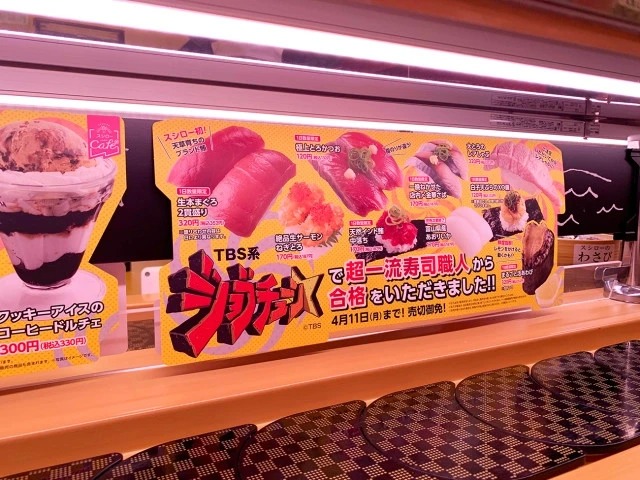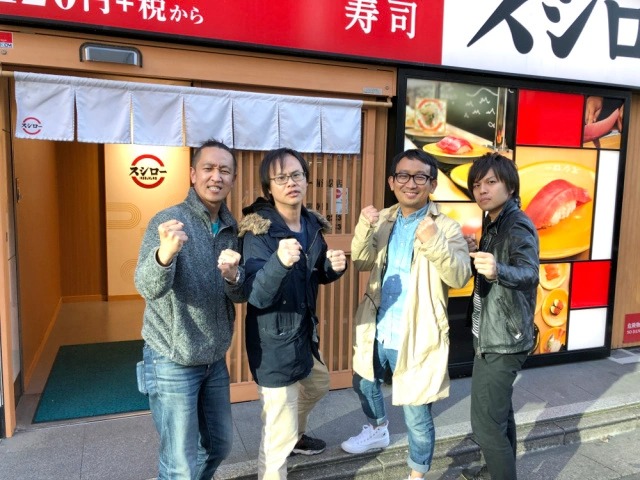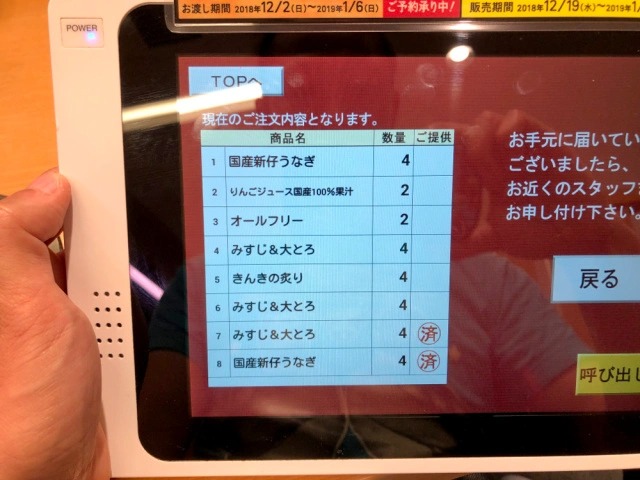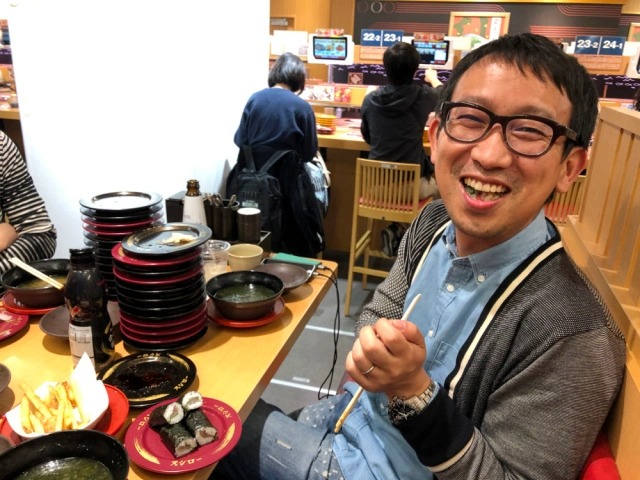
And I don’t feel all that fine.
Much like how a bluebird heralds the beginning of spring, it seems the late winter months in Japan are often greeted by someone doing something horribly disgusting in a revolving sushi restaurant. Whether it’s putting cameras on the belt to peek into everyone’s booth or intentionally dropping fish in the garbage, it seems there is something about the end of the frigid weather that really brings out the jerk in some people.
While this behavior seemed to die down since the pandemic began, it now appears to be back with a vengeance. At the end of January a video went viral of a teen licking various items in his booth like the bottle of soy sauce and a self-service drinking cup, and then returning them for the next customer to unknowingly use at a branch of conveyor belt sushi chain Sushiro in Gifu Prefecture.
▼ Sushiro is one of the leading restaurants of its kind and often enjoyed by our staff
The incident has since been widely dubbed “daeki tero” (saliva terrorism) and the terrorist responsible has since turned himself in to the authorities and, along with his parents, apologized to the company. However, considering the company that owns the restaurant chain saw a five percent dip in stock price right after the video came out, they might not be satisfied with a simple apology.
▼ “Sushiro: If the stock price fell due to soy-sauce-licking shock, that would amount to a loss of 10 billion yen (US$76M) in total market value at this point in time. If that store in Gifu loses sales due to harmful rumors and is forced to close a causal relationship can be confirmed and a claim for damages, including lost profits, could easily amount to hundreds of millions of yen.”
スシロー
— marketmaker (@marketmaker7) January 31, 2023
しょうゆペロペロショックの影響による株価下落であれば、現時点で時価総額が約100億円以上も減ったことになります💦
あの岐阜のお店が風評被害で売上が減少し、閉店なんてことになれば、因果関係が立証されるでしょうから逸失利益も含めて損害賠償請求が軽く億単位になるでしょうね。 pic.twitter.com/r776lY7bId
Not only that but Sushiro along with all the other revolving sushi chains have a major trust issue on their hands. This daeki tero boy is much like a cockroach in that… Actually, he’s like a cockroach in a lot of ways but mainly in that when you see one, you can envision there’re a hundred more out there, and in any posting of the video on social media, you’re sure to find several comments to the effect of, “I’m never eating conveyor belt sushi again.” The idea of having your food float through a room of strangers before eating it became a lot more problematic when COVID-19 hit, and things like daeki tero certainly aren’t helping.
Kura Sushi, another conveyor belt sushi chain, announced that they are installing microchips on the cases that hold the plates of sushi. In addition to monitoring how long they’ve been sitting on the belt, they’ll be able to detect if the case has been tampered with so customers can avoid sushi that may have been compromised.
Meanwhile, Hama Sushi, yet another conveyor belt sushi chain, abolished the public conveyor way back in March 2020 due to the pandemic. Instead, they rely solely on the express belts used by most major chains in which the customer orders from a touchscreen at their seat and their desired dish zooms right to their table. Immediately following the daeki tero incident rumors swirled that Sushiro had gone the same route but the company has officially denied those rumors, saying they are instead making changes to how utensils and seasonings are stored.
▼ Orders can often be made from a tablet installed at each table or the customer’s smartphone.
In addition to keeping it away from idiots, ordering sushi directly way has the added benefits of it being more freshly made and not having to wait for the topping you want to eventually make its way across the entire restaurant at a snail’s pace. It also helps the restaurant to keep a tighter rein on its stock during busy and slow times.
Because of this, express lanes have been in partial use for a long time now, and most people would probably understand if revolving sushi restaurants evolved their conveyor belt system to only use them. Kura Sushi at least seems to be making a concerted effort to maintain the classic formula, but with the increased public awareness of incidents like daeki tero, it’s difficult to say how long even they can hold on.
However, one of the many comments about this issue posed the most important existential question:
“If a revolving sushi restaurant’s sushi doesn’t revolve, isn’t it just a regular sushi restaurant?”
“I don’t see how any of this is protecting the soy sauce and cups though.”
“They’ll have to switch to individually packaged sauce and paper cups. It’s not great for the environment though.”
“Just keeping the food stocked in the back is fine. We don’t need it moving around.”
“I’m fine with takeout, thanks.”
“I think even if there’re only express belts there’ll be guys trying to spit on it as it moves past.”
“How about banning anyone under 18 from entering?”
“Whatever system renovations Sushiro needs to do should be paid for by that daeki tero fool.”
There really is something to just having food casually float by and plucking out whatever looks appealing rather than having to think about what you want to eat. Sometimes, something unexpected passes by and ends up being an especially memorable treat to make the overall experience that much better.
▼ Just look at that smile…
It’ll be sad if that experience disappears, but daeki tero and deadly viruses might end up being why we can’t have nice things.
Source: J-Cast News, Hachima Kiko
Photos ©SoraNews24
● Want to hear about SoraNews24’s latest articles as soon as they’re published? Follow us on Facebook and Twitter!




 Revolving sushi chain Choshimaru’s sushi will no longer revolve in response to “sushi terrorism”
Revolving sushi chain Choshimaru’s sushi will no longer revolve in response to “sushi terrorism” Will virtual plate procession become the new normal for conveyor belt sushi restaurants in Japan?
Will virtual plate procession become the new normal for conveyor belt sushi restaurants in Japan? Kappa Sushi rents out conveyor belt for diners to use at home
Kappa Sushi rents out conveyor belt for diners to use at home Put down the soy sauce! We try a new “expert” way to season your sushi【Taste test】
Put down the soy sauce! We try a new “expert” way to season your sushi【Taste test】 Which Japanese conveyor belt sushi chain has the best scallop sushi?【Taste test】
Which Japanese conveyor belt sushi chain has the best scallop sushi?【Taste test】 Foreigner’s request for help in Tokyo makes us sad for the state of society
Foreigner’s request for help in Tokyo makes us sad for the state of society Japanese city loses residents’ personal data, which was on paper being transported on a windy day
Japanese city loses residents’ personal data, which was on paper being transported on a windy day Seaside scenery, history, and so many desserts on Yokohama’s Akai Kutsu【Japan Loop Buses】
Seaside scenery, history, and so many desserts on Yokohama’s Akai Kutsu【Japan Loop Buses】 Should you add tartar sauce to Japanese curry rice? CoCo Ichi makes diners an unusual offer
Should you add tartar sauce to Japanese curry rice? CoCo Ichi makes diners an unusual offer Akihabara pop-up shop sells goods made by Japanese prison inmates
Akihabara pop-up shop sells goods made by Japanese prison inmates Osaka governor suggests lowering voting age to 0 to curb population decline
Osaka governor suggests lowering voting age to 0 to curb population decline Harajuku Station’s beautiful old wooden building is set to return, with a new complex around it
Harajuku Station’s beautiful old wooden building is set to return, with a new complex around it Suntory x Super Mario collaboration creates a clever way to transform into Mario【Videos】
Suntory x Super Mario collaboration creates a clever way to transform into Mario【Videos】 Toll fees officially added to Mt. Fuji hiking trail
Toll fees officially added to Mt. Fuji hiking trail Japanese company uses “crow language” to keep them away from garbage 【Video】
Japanese company uses “crow language” to keep them away from garbage 【Video】 McDonald’s new Happy Meals offer up cute and practical Sanrio lifestyle goods
McDonald’s new Happy Meals offer up cute and practical Sanrio lifestyle goods Japanese ramen restaurants under pressure from new yen banknotes
Japanese ramen restaurants under pressure from new yen banknotes French Fries Bread in Tokyo’s Shibuya becomes a hit on social media
French Fries Bread in Tokyo’s Shibuya becomes a hit on social media Studio Ghibli releases new action figures featuring Nausicaä of the Valley of the Wind characters
Studio Ghibli releases new action figures featuring Nausicaä of the Valley of the Wind characters Red light district sushi restaurant in Tokyo shows us just how wrong we were about it
Red light district sushi restaurant in Tokyo shows us just how wrong we were about it New private rooms on Tokaido Shinkansen change the way we travel from Tokyo to Kyoto
New private rooms on Tokaido Shinkansen change the way we travel from Tokyo to Kyoto Tokyo Tsukiji fish market site to be redeveloped with 50,000-seat stadium, hotel, shopping center
Tokyo Tsukiji fish market site to be redeveloped with 50,000-seat stadium, hotel, shopping center Beautiful Ghibli sealing wax kits let you create accessories and elegant letter decorations【Pics】
Beautiful Ghibli sealing wax kits let you create accessories and elegant letter decorations【Pics】 Studio Ghibli releases Kiki’s Delivery Service chocolate cake pouches in Japan
Studio Ghibli releases Kiki’s Delivery Service chocolate cake pouches in Japan New definition of “Japanese whiskey” goes into effect to prevent fakes from fooling overseas buyers
New definition of “Japanese whiskey” goes into effect to prevent fakes from fooling overseas buyers Our Japanese reporter visits Costco in the U.S., finds super American and very Japanese things
Our Japanese reporter visits Costco in the U.S., finds super American and very Japanese things All-you-can-drink Starbucks and amazing views part of Tokyo’s new 170 meter-high sky lounge
All-you-can-drink Starbucks and amazing views part of Tokyo’s new 170 meter-high sky lounge More foreign tourists than ever before in history visited Japan last month
More foreign tourists than ever before in history visited Japan last month New Pokémon cakes let you eat your way through Pikachu and all the Eevee evolutions
New Pokémon cakes let you eat your way through Pikachu and all the Eevee evolutions Disney princesses get official manga makeovers for Manga Princess Cafe opening in Tokyo
Disney princesses get official manga makeovers for Manga Princess Cafe opening in Tokyo Sales of Japan’s most convenient train ticket/shopping payment cards suspended indefinitely
Sales of Japan’s most convenient train ticket/shopping payment cards suspended indefinitely Sold-out Studio Ghibli desktop humidifiers are back so Totoro can help you through the dry season
Sold-out Studio Ghibli desktop humidifiers are back so Totoro can help you through the dry season Japanese government to make first change to romanization spelling rules since the 1950s
Japanese government to make first change to romanization spelling rules since the 1950s Ghibli founders Toshio Suzuki and Hayao Miyazaki contribute to Japanese whisky Totoro label design
Ghibli founders Toshio Suzuki and Hayao Miyazaki contribute to Japanese whisky Totoro label design Doraemon found buried at sea as scene from 1993 anime becomes real life【Photos】
Doraemon found buried at sea as scene from 1993 anime becomes real life【Photos】 Tokyo’s most famous Starbucks is closed
Tokyo’s most famous Starbucks is closed One Piece characters’ nationalities revealed, but fans have mixed opinions
One Piece characters’ nationalities revealed, but fans have mixed opinions We asked a Uniqlo employee what four things we should buy and their suggestions didn’t disappoint
We asked a Uniqlo employee what four things we should buy and their suggestions didn’t disappoint Princesses, fruits, and blacksmiths: Study reveals the 30 most unusual family names in Japan
Princesses, fruits, and blacksmiths: Study reveals the 30 most unusual family names in Japan Meat lovers, you can now satisfy your carnivorous cravings at this revolving sushi restaurant!
Meat lovers, you can now satisfy your carnivorous cravings at this revolving sushi restaurant! Japanese restaurant serves up the biggest sushi we’ve ever seen!
Japanese restaurant serves up the biggest sushi we’ve ever seen! Conveyor belt sushi restaurants in Japan now offer random airline ticket discount gacha capsules
Conveyor belt sushi restaurants in Japan now offer random airline ticket discount gacha capsules Which Japanese conveyor belt sushi chain has the best bintoro sushi?【Taste test】
Which Japanese conveyor belt sushi chain has the best bintoro sushi?【Taste test】 Japan’s Sushiro revolving sushi chain stops revolving with conveyor-less food court branch
Japan’s Sushiro revolving sushi chain stops revolving with conveyor-less food court branch Sushiro is making sushi so delicious that even McDonald’s should be worried
Sushiro is making sushi so delicious that even McDonald’s should be worried Our reporter dishes on the differences between sushi from Ginza Kyubey and Sushiro【Taste test】
Our reporter dishes on the differences between sushi from Ginza Kyubey and Sushiro【Taste test】 We investigate the half-priced beer at Sushiro that everyone is angry about
We investigate the half-priced beer at Sushiro that everyone is angry about Which Japanese conveyor belt sushi chain has the best salmon sushi?【Taste test】
Which Japanese conveyor belt sushi chain has the best salmon sushi?【Taste test】 Have your dessert/drink in a bowl of melon — at revolving sushi restaurant Sushiro!
Have your dessert/drink in a bowl of melon — at revolving sushi restaurant Sushiro! Sushi from a vending machine — would you try it? Mr. Sato did
Sushi from a vending machine — would you try it? Mr. Sato did Conveyor belt sushi chain taking the bold, eco-friendly step of getting rid of all its conveyors
Conveyor belt sushi chain taking the bold, eco-friendly step of getting rid of all its conveyors “Sushi terrorist” found guilty in Nagoya District Court
“Sushi terrorist” found guilty in Nagoya District Court Which Japanese conveyor belt sushi chain has the best negitoro sushi?【Taste test】
Which Japanese conveyor belt sushi chain has the best negitoro sushi?【Taste test】 This type of conveyor belt sushi tastes different in Tokyo than it does in Osaka, but why?
This type of conveyor belt sushi tastes different in Tokyo than it does in Osaka, but why?
Leave a Reply